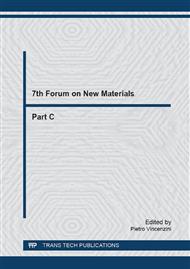p.40
p.48
p.54
p.61
p.69
p.75
p.81
p.90
p.94
The Resistive Switching Behavior of ZnO Films Depending on Li Dopant Concentration and Electrode Materials
Abstract:
Lithium (0, 1.0 and 10 at.%)-doped ZnO (LiZnO) polycrystalline thin films were deposited on Pt/SiO2, LaB6/Al2O3, Au/SiO2 and 20 at.% fluorine-doped SnO2(FTO)/glass substrates by an e-beam evaporation method. Metal/LiZnO/Metal sandwich structures were constructed by depositing different top electrodes (Ag, Al and Au) to find memristive characteristics depending on the lithium content and electrode materials. Compared with undoped and 1%Li-doped ZnO devices, the 10 at.%Li-doped ZnO (10LiZnO) device exhibits resistive switching memory. The Ag/10LiZnO/Pt and Ag/10LiZnO/LaB6 memory devices exhibit unipolar resistive switching behavior while bipolar resistive switching in Ag/10LiZnO/FTO, Au/10LiZnO/FTO and Al/10LiZnO/LaB6 structures is revealed. The dominant conduction mechanisms are explained in terms of Ohmic behavior, space charge limited current (SCLC) and Schottky emission for the URS and BRS behaviors.
Info:
Periodical:
Pages:
75-80
Citation:
Online since:
October 2016
Keywords:
Price:
Сopyright:
© 2017 Trans Tech Publications Ltd. All Rights Reserved
Share:
Citation:


